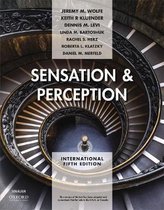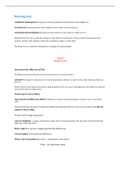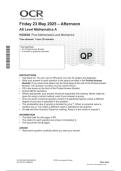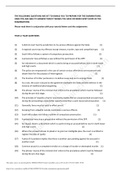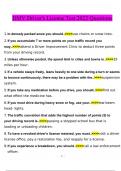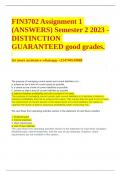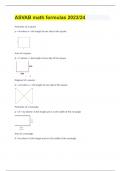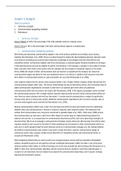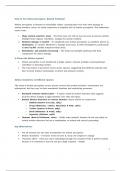Hearing Loss
conductive hearing loss Hearing loss caused by problems with the bones of the middle ear.
otosclerosis Abnormal growth of the middle-ear bones that causes hearing loss.
sensorineural hearing loss Hearing loss due to defects in the cochlea or auditory nerve
Metabolic losses are caused by changes in the fluid environment of the cochlea that decrease the
activity of hair cells. Sensory losses are caused by injury to hair cells
Hearing loss is a natural consequence of aging for many people
Task 8:
Wolfe Ch.10:
interaural time difference (ITD)
The difference in time between arrivals of sound at one ear versus the other.
azimuth The angle of a sound source on the horizontal plane relative to a point in the center of the head between
the ears.
Works well for low frequencies because in high frequencies two ears cannot distinguish the time difference between
the interval of the two frequencies.
Medial superior olives (MSOs)
interaural level difference (ILD) The difference between levels (intensities) of sound at one ear versus the
other.
Neurons that are sensitive to intensity differences between the two ears can be found in the lateral
superior olives (LSOs)
Works well for high frequencies
cone of confusion : A region of positions in space where all sounds produce the same time and level (intensity)
differences (ITDs and ILDs).
Place code? For narrow coding, specific time differences
Neural coding? For broad time differences
Where and what pathways: where = localization of the sound
What = for identifying sound
, Listeners are best at judging the distance to a sound source when it is about 1 meter away. Closer than
that, listeners overestimate distance, while they underestimate distance to the source when it is
farther than 1 meter
inverse-square law A principle stating that as distance from a source increases, intensity decreases faster such
that decrease in intensity is equal to the distance squared. This general law also applies to optics and other forms of
energy.
fundamental frequency : The lowest-frequency component of a complex periodic sound.
timbre The psychological sensation by which a listener can judge that two sounds with the same loudness and pitch
are dissimilar. Timbre quality is conveyed by harmonics and other high frequencies.
attack :The part of a sound during which amplitude increases (onset).
Decay: The part of a sound during which amplitude decreases (offset).
Spatial, Spectral, and Temporal Segregation
source segregation or auditory scene analysis Processing an auditory scene consisting of multiple sound
sources into separate sound images.
One of the most obvious strategies is spatial separation between sounds. Sounds that emanate from
the same location in space can typically be treated as if they arose from the same source.
sounds with the same pitch or similar pitches are more likely to be treated as coming from the same
source and to be segregated from other sounds.
auditory stream segregation The perceptual organization of a complex acoustic signal into separate auditory
events for which each stream is heard as a separate event
Gestalt principle of similarity : sounds that are similar to each other tend to be grouped together into
streams
Figure 10.26 Timbre affects how sounds are grouped. (A) Individual tones
(green) “pop out” of a stream if they do not fit the patterns of rising or
falling frequency for the other tones (red). (B, C) Sounds that share the
same timbre group together. When sounds in a suc- cession all share the
same timbre (B), they are heard as streams according to similar frequency.
But if sounds have different timbres (C), they will separate according to
timbre, even if their fre- quencies cross another pattern with a different
timbre.
conductive hearing loss Hearing loss caused by problems with the bones of the middle ear.
otosclerosis Abnormal growth of the middle-ear bones that causes hearing loss.
sensorineural hearing loss Hearing loss due to defects in the cochlea or auditory nerve
Metabolic losses are caused by changes in the fluid environment of the cochlea that decrease the
activity of hair cells. Sensory losses are caused by injury to hair cells
Hearing loss is a natural consequence of aging for many people
Task 8:
Wolfe Ch.10:
interaural time difference (ITD)
The difference in time between arrivals of sound at one ear versus the other.
azimuth The angle of a sound source on the horizontal plane relative to a point in the center of the head between
the ears.
Works well for low frequencies because in high frequencies two ears cannot distinguish the time difference between
the interval of the two frequencies.
Medial superior olives (MSOs)
interaural level difference (ILD) The difference between levels (intensities) of sound at one ear versus the
other.
Neurons that are sensitive to intensity differences between the two ears can be found in the lateral
superior olives (LSOs)
Works well for high frequencies
cone of confusion : A region of positions in space where all sounds produce the same time and level (intensity)
differences (ITDs and ILDs).
Place code? For narrow coding, specific time differences
Neural coding? For broad time differences
Where and what pathways: where = localization of the sound
What = for identifying sound
, Listeners are best at judging the distance to a sound source when it is about 1 meter away. Closer than
that, listeners overestimate distance, while they underestimate distance to the source when it is
farther than 1 meter
inverse-square law A principle stating that as distance from a source increases, intensity decreases faster such
that decrease in intensity is equal to the distance squared. This general law also applies to optics and other forms of
energy.
fundamental frequency : The lowest-frequency component of a complex periodic sound.
timbre The psychological sensation by which a listener can judge that two sounds with the same loudness and pitch
are dissimilar. Timbre quality is conveyed by harmonics and other high frequencies.
attack :The part of a sound during which amplitude increases (onset).
Decay: The part of a sound during which amplitude decreases (offset).
Spatial, Spectral, and Temporal Segregation
source segregation or auditory scene analysis Processing an auditory scene consisting of multiple sound
sources into separate sound images.
One of the most obvious strategies is spatial separation between sounds. Sounds that emanate from
the same location in space can typically be treated as if they arose from the same source.
sounds with the same pitch or similar pitches are more likely to be treated as coming from the same
source and to be segregated from other sounds.
auditory stream segregation The perceptual organization of a complex acoustic signal into separate auditory
events for which each stream is heard as a separate event
Gestalt principle of similarity : sounds that are similar to each other tend to be grouped together into
streams
Figure 10.26 Timbre affects how sounds are grouped. (A) Individual tones
(green) “pop out” of a stream if they do not fit the patterns of rising or
falling frequency for the other tones (red). (B, C) Sounds that share the
same timbre group together. When sounds in a suc- cession all share the
same timbre (B), they are heard as streams according to similar frequency.
But if sounds have different timbres (C), they will separate according to
timbre, even if their fre- quencies cross another pattern with a different
timbre.

